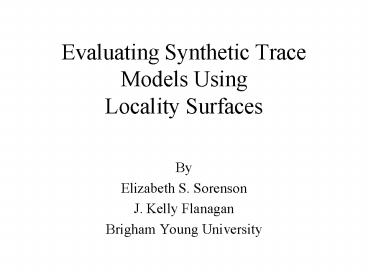Evaluating Synthetic Trace Models Using Locality Surfaces PowerPoint PPT Presentation
1 / 33
Title: Evaluating Synthetic Trace Models Using Locality Surfaces
1
Evaluating Synthetic Trace Models UsingLocality
Surfaces
- By
- Elizabeth S. Sorenson
- J. Kelly Flanagan
- Brigham Young University
2
Trace-Driven Simulation
- Popular method for evaluating caches
- The larger the cache, the longer the trace needed
- Long traces require large storage
- One solution Synthetic Traces
3
Synthetic Traces
- Small storage requirements
- Extract limited number of parameters from a real
trace - Can create an arbitrarily long trace
- Can create traces for future workloads and
systems - Tend to be inaccurate
4
Which Synthetic Trace Models
- Independent Reference Model
- Stack Model
- Partial Markov Model
- Distance Model
- Distance-Strings Model
5
Evaluation Methods
- Locality Surfaces
- Programs tend to use a small portion of memory
most of the time - Principle that caches are based on
- Cache simulation results (miss rate)
- Use configurations typical of level one caches
- Size 32 Kbyte to 64 Kbyte
- 1-way associative to 8-way associative
6
Locality Surface
- Good way to visualize locality
- Incorporates both temporal and spatial locality
- Useful for qualitatively predicting cache
performance
7
Example Locality Surface
8
Traces Used
- Twolf from SPECint2000 benchmark suite
- Collected using the BACH method
- Pentium III, Redhat Linux 6.2
- Separate instruction fetches and data reads and
writes
9
Twolf Instruction Fetches
10
Twolf Data Reads and Writes
11
Independent Reference Model
- Determine the frequency of any given memory
address occurring in original trace - Use the frequencies as probabilities
- Generate references based on these probabilities
12
IRM Instruction Fetches
Original
IRM
13
IRM Data Reads Writes
Original
IRM
14
IRM compare stride0 axis
Instruction Fetches
Data Reads And Writes
15
Stack Model
- Maintain an LRU stack of references seen
- Record frequency of accessing references x deep
in stack - Use these frequencies to generate references
- When generating a reference not in the stack, use
a random reference
16
SM Instruction Fetches
Original
SM
17
SM Data Reads Writes
Original
SM
18
SM compare stride0 axis
Instruction Fetches
Data Reads And Writes
19
Partial Markov Model
- Assumes all references either random or
sequential - Determines probabilities of changing states vs.
staying the same
20
PMM Instruction Fetches
Original
PMM
21
PMM Data Reads Writes
Original
PMM
22
Distance Model
- Determine frequency of any stride occurring
between successive entries in trace - When generating references, generate a stride
from the stored distribution and add it to
previous reference
23
DM Instruction Fetches
Original
DM
24
DM Data Reads Writes
Original
DM
25
DM compare delay1 axis
Instruction Fetches
Data Reads And Writes
26
Distance-Strings Model
- Again uses frequencies of strides occurring,
except uses strides between the start of bursts
of sequential references - Also uses the frequencies of the lengths of
sequential bursts
27
DSM Instruction Fetches
Original
DSM
28
DSM Data Reads Writes
Original
DSM
29
DSM compare delay1 axis
Instruction Fetches
Data Reads And Writes
30
Instruction FetchesCache Simulation Results
31
Data Reads WritesCache Simulation Results
32
Conclusions
- None of these models adequately replicate all
aspects of locality - IMR and SM do approximate the effective working
set size to some degree - IRM, SM, and DM mostly successful at the aspects
of locality they intended to produce
33
Future Work
- This is only the first step in the process
- We will evaluate in a similar fashion some more
recent models - GOAL a synthetic trace generation model based on
the locality surface

